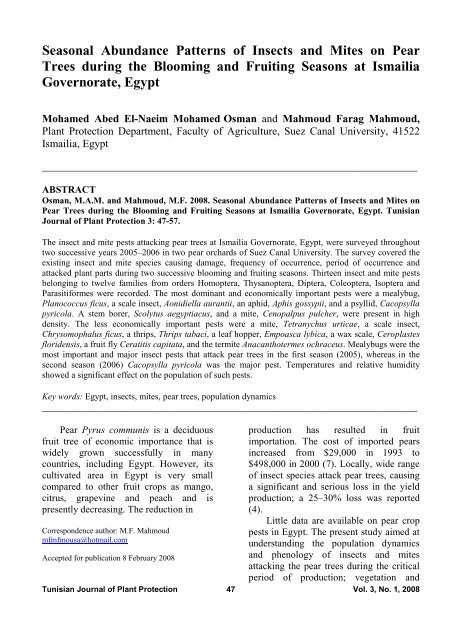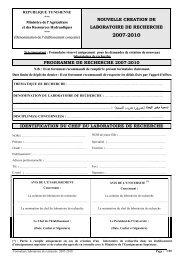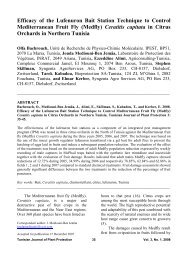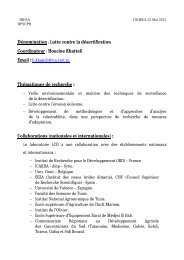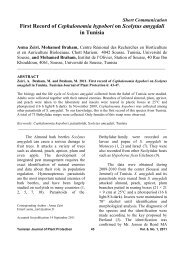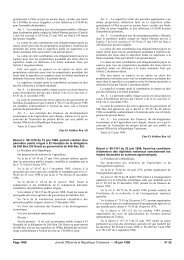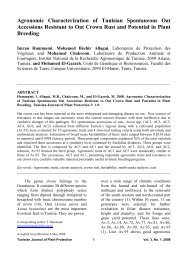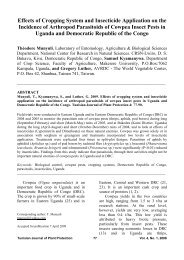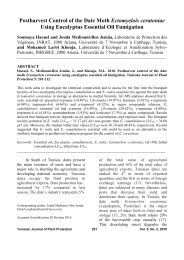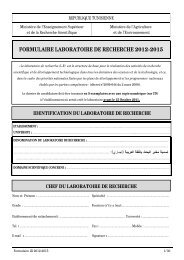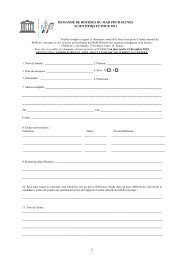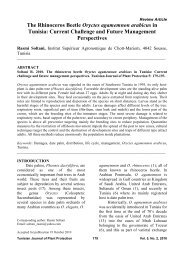Seasonal Abundance Patterns of Insects and Mites on Pear ... - Iresa
Seasonal Abundance Patterns of Insects and Mites on Pear ... - Iresa
Seasonal Abundance Patterns of Insects and Mites on Pear ... - Iresa
You also want an ePaper? Increase the reach of your titles
YUMPU automatically turns print PDFs into web optimized ePapers that Google loves.
<str<strong>on</strong>g>Seas<strong>on</strong>al</str<strong>on</strong>g> <str<strong>on</strong>g>Abundance</str<strong>on</strong>g> <str<strong>on</strong>g>Patterns</str<strong>on</strong>g> <str<strong>on</strong>g>of</str<strong>on</strong>g> <str<strong>on</strong>g>Insects</str<strong>on</strong>g> <str<strong>on</strong>g>and</str<strong>on</strong>g> <str<strong>on</strong>g>Mites</str<strong>on</strong>g> <strong>on</strong> <strong>Pear</strong><br />
Trees during the Blooming <str<strong>on</strong>g>and</str<strong>on</strong>g> Fruiting Seas<strong>on</strong>s at Ismailia<br />
Governorate, Egypt<br />
Mohamed Abed El-Naeim Mohamed Osman <str<strong>on</strong>g>and</str<strong>on</strong>g> Mahmoud Farag Mahmoud,<br />
Plant Protecti<strong>on</strong> Department, Faculty <str<strong>on</strong>g>of</str<strong>on</strong>g> Agriculture, Suez Canal University, 41522<br />
Ismailia, Egypt<br />
____________________________________________________________________________<br />
ABSTRACT<br />
Osman, M.A.M. <str<strong>on</strong>g>and</str<strong>on</strong>g> Mahmoud, M.F. 2008. <str<strong>on</strong>g>Seas<strong>on</strong>al</str<strong>on</strong>g> <str<strong>on</strong>g>Abundance</str<strong>on</strong>g> <str<strong>on</strong>g>Patterns</str<strong>on</strong>g> <str<strong>on</strong>g>of</str<strong>on</strong>g> <str<strong>on</strong>g>Insects</str<strong>on</strong>g> <str<strong>on</strong>g>and</str<strong>on</strong>g> <str<strong>on</strong>g>Mites</str<strong>on</strong>g> <strong>on</strong><br />
<strong>Pear</strong> Trees during the Blooming <str<strong>on</strong>g>and</str<strong>on</strong>g> Fruiting Seas<strong>on</strong>s at Ismailia Governorate, Egypt. Tunisian<br />
Journal <str<strong>on</strong>g>of</str<strong>on</strong>g> Plant Protecti<strong>on</strong> 3: 47-57.<br />
The insect <str<strong>on</strong>g>and</str<strong>on</strong>g> mite pests attacking pear trees at Ismailia Governorate, Egypt, were surveyed throughout<br />
two successive years 2005–2006 in two pear orchards <str<strong>on</strong>g>of</str<strong>on</strong>g> Suez Canal University. The survey covered the<br />
existing insect <str<strong>on</strong>g>and</str<strong>on</strong>g> mite species causing damage, frequency <str<strong>on</strong>g>of</str<strong>on</strong>g> occurrence, period <str<strong>on</strong>g>of</str<strong>on</strong>g> occurrence <str<strong>on</strong>g>and</str<strong>on</strong>g><br />
attacked plant parts during two successive blooming <str<strong>on</strong>g>and</str<strong>on</strong>g> fruiting seas<strong>on</strong>s. Thirteen insect <str<strong>on</strong>g>and</str<strong>on</strong>g> mite pests<br />
bel<strong>on</strong>ging to twelve families from orders Homoptera, Thysanoptera, Diptera, Coleoptera, Isoptera <str<strong>on</strong>g>and</str<strong>on</strong>g><br />
Parasitiformes were recorded. The most dominant <str<strong>on</strong>g>and</str<strong>on</strong>g> ec<strong>on</strong>omically important pests were a mealybug,<br />
Planococcus ficus, a scale insect, A<strong>on</strong>idiella aurantii, an aphid, Aphis gossypii, <str<strong>on</strong>g>and</str<strong>on</strong>g> a psyllid, Cacopsylla<br />
pyricola. A stem borer, Scolytus aegyptiacus, <str<strong>on</strong>g>and</str<strong>on</strong>g> a mite, Cenopalpus pulcher, were present in high<br />
density. The less ec<strong>on</strong>omically important pests were a mite, Tetranychus urticae, a scale insect,<br />
Chrysomophalus ficus, a thrips, Thrips tabaci, a leaf hopper, Empoasca lybica, a wax scale, Ceroplastes<br />
floridensis, a fruit fly Ceratitis capitata, <str<strong>on</strong>g>and</str<strong>on</strong>g> the termite Anacanthotermes ochraceus. Mealybugs were the<br />
most important <str<strong>on</strong>g>and</str<strong>on</strong>g> major insect pests that attack pear trees in the first seas<strong>on</strong> (2005), whereas in the<br />
sec<strong>on</strong>d seas<strong>on</strong> (2006) Cacopsylla pyricola was the major pest. Temperatures <str<strong>on</strong>g>and</str<strong>on</strong>g> relative humidity<br />
showed a significant effect <strong>on</strong> the populati<strong>on</strong> <str<strong>on</strong>g>of</str<strong>on</strong>g> such pests.<br />
Key words: Egypt, insects, mites, pear trees, populati<strong>on</strong> dynamics<br />
____________________________________________________________________________<br />
<strong>Pear</strong> Pyrus communis is a deciduous<br />
fruit tree <str<strong>on</strong>g>of</str<strong>on</strong>g> ec<strong>on</strong>omic importance that is<br />
widely grown successfully in many<br />
countries, including Egypt. However, its<br />
cultivated area in Egypt is very small<br />
compared to other fruit crops as mango,<br />
citrus, grapevine <str<strong>on</strong>g>and</str<strong>on</strong>g> peach <str<strong>on</strong>g>and</str<strong>on</strong>g> is<br />
presently decreasing. The reducti<strong>on</strong> in<br />
Corresp<strong>on</strong>dence author: M.F. Mahmoud<br />
mfmfmousa@hotmail.com<br />
Accepted for publicati<strong>on</strong> 8 February 2008<br />
producti<strong>on</strong> has resulted in fruit<br />
importati<strong>on</strong>. The cost <str<strong>on</strong>g>of</str<strong>on</strong>g> imported pears<br />
increased from $29,000 in 1993 to<br />
$498,000 in 2000 (7). Locally, wide range<br />
<str<strong>on</strong>g>of</str<strong>on</strong>g> insect species attack pear trees, causing<br />
a significant <str<strong>on</strong>g>and</str<strong>on</strong>g> serious loss in the yield<br />
producti<strong>on</strong>; a 25–30% loss was reported<br />
(4).<br />
Little data are available <strong>on</strong> pear crop<br />
pests in Egypt. The present study aimed at<br />
underst<str<strong>on</strong>g>and</str<strong>on</strong>g>ing the populati<strong>on</strong> dynamics<br />
<str<strong>on</strong>g>and</str<strong>on</strong>g> phenology <str<strong>on</strong>g>of</str<strong>on</strong>g> insects <str<strong>on</strong>g>and</str<strong>on</strong>g> mites<br />
attacking the pear trees during the critical<br />
period <str<strong>on</strong>g>of</str<strong>on</strong>g> producti<strong>on</strong>; vegetati<strong>on</strong> <str<strong>on</strong>g>and</str<strong>on</strong>g><br />
Tunisian Journal <str<strong>on</strong>g>of</str<strong>on</strong>g> Plant Protecti<strong>on</strong> 47<br />
Vol. 3, No. 1, 2008
fruiting from March to June. In France, a<br />
survey <str<strong>on</strong>g>of</str<strong>on</strong>g> arthropods was c<strong>on</strong>ducted (18)<br />
to determine the role <str<strong>on</strong>g>of</str<strong>on</strong>g> hedgerows <str<strong>on</strong>g>and</str<strong>on</strong>g><br />
ground cover management <strong>on</strong> their<br />
populati<strong>on</strong>s in pear orchards. In Saudi<br />
Arabia, a general survey <str<strong>on</strong>g>of</str<strong>on</strong>g> agricultural<br />
pests <strong>on</strong> fruit trees was performed (1). In<br />
Egypt, survey <str<strong>on</strong>g>of</str<strong>on</strong>g> mites was reported <strong>on</strong><br />
deciduous fruit trees (6, 22).<br />
MATERIALS AND METHODS<br />
Surveys <str<strong>on</strong>g>of</str<strong>on</strong>g> the insect <str<strong>on</strong>g>and</str<strong>on</strong>g> mite pests<br />
attacking pear trees at Ismailia<br />
Governorate, Egypt, were carried out<br />
throughout two successive vegetating <str<strong>on</strong>g>and</str<strong>on</strong>g><br />
fruiting seas<strong>on</strong>s, from March 2005 until<br />
June 2006. Two pear orchards at Suez<br />
Canal University were selected. The first<br />
was located in the new farm, Faculty <str<strong>on</strong>g>of</str<strong>on</strong>g><br />
Agriculture, it corresp<strong>on</strong>ds to an area <str<strong>on</strong>g>of</str<strong>on</strong>g><br />
1600 m 2 including 72 pear trees (cv Le-<br />
C<strong>on</strong>te). The sec<strong>on</strong>d was located in the old<br />
farm, Faculty <str<strong>on</strong>g>of</str<strong>on</strong>g> Agriculture, 4.5 km from<br />
the first site size <str<strong>on</strong>g>and</str<strong>on</strong>g> included twelve trees<br />
variety Calyriana.<br />
In each site, 5 trees were selected<br />
r<str<strong>on</strong>g>and</str<strong>on</strong>g>omly, <strong>on</strong>e from every corner <str<strong>on</strong>g>and</str<strong>on</strong>g> the<br />
fifth from the middle. Samples were taken<br />
from the selected trees three times<br />
m<strong>on</strong>thly. Four branches <strong>on</strong>e to two years<br />
old, 20 cm in length were cut per tree <str<strong>on</strong>g>and</str<strong>on</strong>g><br />
transferred in paper bags to the laboratory<br />
for proper identificati<strong>on</strong> <str<strong>on</strong>g>of</str<strong>on</strong>g> insects (16).<br />
Laboratory identificati<strong>on</strong> <str<strong>on</strong>g>of</str<strong>on</strong>g> the specimens<br />
was made either under the binocular<br />
microscope or after mounting <strong>on</strong><br />
microscopic slides.<br />
All parts <str<strong>on</strong>g>of</str<strong>on</strong>g> the samples were<br />
inspected <str<strong>on</strong>g>and</str<strong>on</strong>g> recorded; i.e., the branches<br />
length, number <str<strong>on</strong>g>of</str<strong>on</strong>g> leaves <str<strong>on</strong>g>and</str<strong>on</strong>g> number <str<strong>on</strong>g>of</str<strong>on</strong>g><br />
buds. Any existing major or minor insect<br />
<str<strong>on</strong>g>and</str<strong>on</strong>g> mite pests were recorded <str<strong>on</strong>g>and</str<strong>on</strong>g><br />
identified directly as much as possible in<br />
the laboratory. Also, plant parts attacked<br />
(leaves – wood – buds – fruits) were<br />
recorded (20). The numbers <str<strong>on</strong>g>of</str<strong>on</strong>g> the<br />
different pests attacking pear trees during<br />
the blooming period were recorded at the<br />
selected areas throughout the inspecting<br />
samples.<br />
Records <str<strong>on</strong>g>of</str<strong>on</strong>g> the average temperature<br />
<str<strong>on</strong>g>and</str<strong>on</strong>g> relative humidity, throughout the<br />
inspected periods were obtained from the<br />
meteorological stati<strong>on</strong> bel<strong>on</strong>ging to the<br />
Department <str<strong>on</strong>g>of</str<strong>on</strong>g> the Ministry <str<strong>on</strong>g>of</str<strong>on</strong>g> Agriculture<br />
at Ismailia Governorate.<br />
RESULTS<br />
Insect <str<strong>on</strong>g>and</str<strong>on</strong>g> mite pests recorded. Main<br />
insect <str<strong>on</strong>g>and</str<strong>on</strong>g> mite pests <str<strong>on</strong>g>and</str<strong>on</strong>g> damage level are<br />
summarized Table 1. Recorded pests could<br />
be divided into 10 groups; Mealybugs,<br />
Aphids, Psyllids, Scale insects, Leaf<br />
hoppers, Thrips, Stem borers, Fruit flies,<br />
Termites <str<strong>on</strong>g>and</str<strong>on</strong>g> <str<strong>on</strong>g>Mites</str<strong>on</strong>g>.<br />
One species <str<strong>on</strong>g>of</str<strong>on</strong>g> mealybug; the vine<br />
mealybug Planococcus ficus<br />
(Pseudococcidae) was found to cause<br />
serious damage to pear trees almost during<br />
the whole period <str<strong>on</strong>g>of</str<strong>on</strong>g> the survey. It mainly<br />
attacks leaves followed by woody parts <str<strong>on</strong>g>and</str<strong>on</strong>g><br />
was slightly observed <strong>on</strong> fruits.<br />
The aphid, Aphis gossypii<br />
(Aphididae), was also frequently recorded<br />
<str<strong>on</strong>g>and</str<strong>on</strong>g> appears to be an important pest in pear<br />
orchards; sucking sap from leaves <str<strong>on</strong>g>and</str<strong>on</strong>g><br />
young shoots <str<strong>on</strong>g>and</str<strong>on</strong>g> flowers.<br />
The European pear sucker plant louse,<br />
Cacopsylla pyricola (Psyllidae), is <strong>on</strong>e <str<strong>on</strong>g>of</str<strong>on</strong>g><br />
the most menacing insect pests <str<strong>on</strong>g>of</str<strong>on</strong>g> pears in<br />
many countries. As far as the present<br />
authors are aware, no informati<strong>on</strong> was<br />
previously reported for the presence <str<strong>on</strong>g>of</str<strong>on</strong>g> this<br />
pest in Egypt. Psyllid insects were<br />
significantly recorded mainly <strong>on</strong> leaves,<br />
flowers <str<strong>on</strong>g>and</str<strong>on</strong>g> buds. It feeds primarily <strong>on</strong><br />
phloem tissues <str<strong>on</strong>g>and</str<strong>on</strong>g> it is a host specific to<br />
certain Pyrus spp.<br />
Two species <str<strong>on</strong>g>of</str<strong>on</strong>g> scale insects,<br />
A<strong>on</strong>idiella aurantii <str<strong>on</strong>g>and</str<strong>on</strong>g> Chrysomphalus<br />
ficus (Diaspididae) existed all the seas<strong>on</strong>;<br />
mainly <strong>on</strong> wood <str<strong>on</strong>g>and</str<strong>on</strong>g> rarely <strong>on</strong> leaves.<br />
Tunisian Journal <str<strong>on</strong>g>of</str<strong>on</strong>g> Plant Protecti<strong>on</strong> 48<br />
Vol. 3, No. 1, 2008
Table 1: List <str<strong>on</strong>g>of</str<strong>on</strong>g> insect <str<strong>on</strong>g>and</str<strong>on</strong>g> mite pests attacking different plant parts <str<strong>on</strong>g>of</str<strong>on</strong>g> pear trees during the blooming seas<strong>on</strong>s,<br />
2005 <str<strong>on</strong>g>and</str<strong>on</strong>g> 2006 in two pear orchards at Ismailia governorate.<br />
No.<br />
1<br />
2<br />
3<br />
4<br />
5<br />
6<br />
7<br />
8<br />
9<br />
10<br />
Pest Family Order<br />
Mealybug<br />
Planococcus ficus<br />
Aphid<br />
Aphis gossypii<br />
Plant lice<br />
Cacopsylla pyricola<br />
Scale insects<br />
A<strong>on</strong>idiella aurantii<br />
Chrysomophalus ficus<br />
Pseudococcidae<br />
Aphididae<br />
Psyllidae<br />
Diaspididae<br />
Damage plant parts<br />
W. L. Fl. Fr.<br />
Tunisian Journal <str<strong>on</strong>g>of</str<strong>on</strong>g> Plant Protecti<strong>on</strong> 49<br />
Vol. 3, No. 1, 2008<br />
++<br />
--<br />
+<br />
+++<br />
+++<br />
++<br />
++<br />
+<br />
--<br />
+<br />
+<br />
--<br />
+<br />
--<br />
--<br />
--<br />
++ -- -- --<br />
Ceroplastes floridensis Coccidae + + -- --<br />
Leaf hopper<br />
Empoasca lybica<br />
Thrips<br />
Thrips tabaci<br />
Stem borers<br />
Scolytus aegyptiacus<br />
Flies<br />
Ceratitis capitata<br />
Termite<br />
Anacanthotermes ochraceus<br />
<str<strong>on</strong>g>Mites</str<strong>on</strong>g><br />
Tetranychus urticae<br />
Cicadellidae<br />
Thripidae<br />
Scolytidae<br />
Tephritidae<br />
Hodotermitidae<br />
Tetranychidae<br />
Cenopalpus pulcher Tenuipalpidae<br />
Homoptera<br />
Thysanoptera<br />
Coleoptera<br />
Diptera<br />
Isoptera<br />
Class: Acari<br />
Order: Parasitiformes<br />
--<br />
--<br />
+++<br />
--<br />
+<br />
+<br />
+<br />
++<br />
--<br />
--<br />
--<br />
++<br />
+<br />
+<br />
--<br />
--<br />
--<br />
--<br />
--<br />
--<br />
--<br />
+<br />
--<br />
--<br />
+++ ++ -- +<br />
+ low populated pest, ++ mid populated pest, +++ high populated pest <str<strong>on</strong>g>and</str<strong>on</strong>g> -- unrecorded pest in the collected<br />
samples. W. wood, L. leaf, F. flowers <str<strong>on</strong>g>and</str<strong>on</strong>g> Fr. fruits.<br />
Adults <str<strong>on</strong>g>and</str<strong>on</strong>g> nymphs <str<strong>on</strong>g>of</str<strong>on</strong>g> the leaf hopper,<br />
Empoasca lybica (Cicadellidae), were<br />
collected from leaves <str<strong>on</strong>g>and</str<strong>on</strong>g> flowers <str<strong>on</strong>g>of</str<strong>on</strong>g> pear<br />
trees.
The thrips, Thrips tabaci (Thripidae),<br />
was also recorded, especially <strong>on</strong> leaves,<br />
fruits <str<strong>on</strong>g>and</str<strong>on</strong>g> insignificantly <strong>on</strong> flowers.<br />
<strong>Pear</strong> fruits were infested with the fruit<br />
fly Ceratitis capitata (Trypetidae). The<br />
termite species Anacanthotermes<br />
ochraceus (Hodotermitidae) was<br />
infrequently observed <strong>on</strong> the wood, in<br />
some samples.<br />
The flat scarlet mite, Cenopalpus<br />
pulcher (Tenuipalpidae), was a comm<strong>on</strong><br />
pest <strong>on</strong> pear trees during all period <str<strong>on</strong>g>of</str<strong>on</strong>g><br />
study. The mature, immature stages <str<strong>on</strong>g>and</str<strong>on</strong>g><br />
eggs were observed <strong>on</strong> the wood, buds <str<strong>on</strong>g>and</str<strong>on</strong>g><br />
leaves <str<strong>on</strong>g>and</str<strong>on</strong>g> scarcely <strong>on</strong> fruits. Another mite<br />
species, Tetranychus urticae<br />
(Tetranychidae), was also recorded <strong>on</strong><br />
leaves. Some pest species were recorded<br />
infrequently, i.e., the scale insect<br />
Lepidosaphes ulmi (Diaspididae), the<br />
thrips Retithrips syriacus (Thripidae), the<br />
s<str<strong>on</strong>g>of</str<strong>on</strong>g>t scale insect Coccus hespridum<br />
(Coccidae), in additi<strong>on</strong> to mite species as<br />
Tydeus californicus (Tydeidae) <str<strong>on</strong>g>and</str<strong>on</strong>g> pear<br />
mite Eriophes pyri (Eriophyidae).<br />
It is noteworthy to menti<strong>on</strong> that<br />
various natural enemies were also recorded<br />
during investigati<strong>on</strong> for instance, larvae<br />
<str<strong>on</strong>g>and</str<strong>on</strong>g> eggs <str<strong>on</strong>g>of</str<strong>on</strong>g> Chrysoperla carnae,<br />
coccinellid larvae, syrphid larvae <str<strong>on</strong>g>and</str<strong>on</strong>g><br />
nymphs <str<strong>on</strong>g>of</str<strong>on</strong>g> predacious thrips. Moreover,<br />
some species <str<strong>on</strong>g>of</str<strong>on</strong>g> predacious mites were<br />
found such as Cunaxa sp. (Cunaxidae),<br />
Cheyletogenus ornatus (Cheyletidae) <str<strong>on</strong>g>and</str<strong>on</strong>g><br />
Amblyseus sp. (Phytoseidae).<br />
Populati<strong>on</strong> dynamics <str<strong>on</strong>g>of</str<strong>on</strong>g> insect <str<strong>on</strong>g>and</str<strong>on</strong>g><br />
mite pests. The populati<strong>on</strong> dynamic <str<strong>on</strong>g>of</str<strong>on</strong>g><br />
different pests attacking pear trees during<br />
the blooming period at new <str<strong>on</strong>g>and</str<strong>on</strong>g> old<br />
experimental orchards in seas<strong>on</strong> 2005 are<br />
shown in Fig. 1. The pests reached their<br />
maximum populati<strong>on</strong>s in the sec<strong>on</strong>d<br />
decade <str<strong>on</strong>g>of</str<strong>on</strong>g> May when the average <str<strong>on</strong>g>of</str<strong>on</strong>g><br />
temperature <str<strong>on</strong>g>and</str<strong>on</strong>g> relative humidity were<br />
25ºC <str<strong>on</strong>g>and</str<strong>on</strong>g> 50.5 % RH, respectively. The<br />
results showed that the most abundant pest<br />
species were the scale insects, followed by<br />
mites then aphid, mealybugs, leaf hopper,<br />
thrips <str<strong>on</strong>g>and</str<strong>on</strong>g> psylla in the new orchard.<br />
However, in the old orchards the most<br />
dominant species were mites followed by<br />
the mealybugs after that, thrips, scale<br />
insects, leaf hopper <str<strong>on</strong>g>and</str<strong>on</strong>g> aphid, whereas the<br />
psyllid was not recorded in this locati<strong>on</strong>.<br />
In the new orchard, scale insects were<br />
observed in low numbers (with an average<br />
<str<strong>on</strong>g>of</str<strong>on</strong>g> 0.24 individual) <strong>on</strong> pear trees from the<br />
beginning <str<strong>on</strong>g>of</str<strong>on</strong>g> the survey (March 1, 2005)<br />
<str<strong>on</strong>g>and</str<strong>on</strong>g> increased gradually to reach its peak<br />
(7.37 individuals) during the sec<strong>on</strong>d<br />
decade <str<strong>on</strong>g>of</str<strong>on</strong>g> May. The mite populati<strong>on</strong>s<br />
showed two peaks; the first (1.57<br />
individuals) during the sec<strong>on</strong>d decade <str<strong>on</strong>g>of</str<strong>on</strong>g><br />
April at 23.5ºC <str<strong>on</strong>g>and</str<strong>on</strong>g> 50% RH <str<strong>on</strong>g>and</str<strong>on</strong>g> the<br />
sec<strong>on</strong>d (3.78 individuals) in the sec<strong>on</strong>d<br />
decade <str<strong>on</strong>g>of</str<strong>on</strong>g> May at 25ºC <str<strong>on</strong>g>and</str<strong>on</strong>g> 50.5 % RH.<br />
The dynamic <str<strong>on</strong>g>of</str<strong>on</strong>g> aphid populati<strong>on</strong> was<br />
initiated (with an average <str<strong>on</strong>g>of</str<strong>on</strong>g> 0.28<br />
individuals) during the first decade <str<strong>on</strong>g>of</str<strong>on</strong>g><br />
April at 18.5ºC <str<strong>on</strong>g>and</str<strong>on</strong>g> 54.5 % RH to reach its<br />
peak (2.56 individuals) in the sec<strong>on</strong>d<br />
decade <str<strong>on</strong>g>of</str<strong>on</strong>g> May. Mealybugs were recorded<br />
with an average <str<strong>on</strong>g>of</str<strong>on</strong>g> 0.29 individuals in the<br />
sec<strong>on</strong>d decade <str<strong>on</strong>g>of</str<strong>on</strong>g> March at 14.8.5ºC <str<strong>on</strong>g>and</str<strong>on</strong>g><br />
55.5 % RH which decreased gradually to<br />
zero in the first <str<strong>on</strong>g>of</str<strong>on</strong>g> April, then to occur<br />
back to attain the maximum <str<strong>on</strong>g>of</str<strong>on</strong>g> 1.08<br />
individuals in the sec<strong>on</strong>d decade <str<strong>on</strong>g>of</str<strong>on</strong>g> May,<br />
2005. The dynamics <str<strong>on</strong>g>of</str<strong>on</strong>g> leaf hopper, thrips<br />
<str<strong>on</strong>g>and</str<strong>on</strong>g> psylla were slight <str<strong>on</strong>g>and</str<strong>on</strong>g> not c<strong>on</strong>stant.<br />
Leaf hoppers occurred in three periods;<br />
first <str<strong>on</strong>g>of</str<strong>on</strong>g> April (with an average <str<strong>on</strong>g>of</str<strong>on</strong>g> 0.03<br />
individuals), third decade <str<strong>on</strong>g>of</str<strong>on</strong>g> April (0.15<br />
individuals) at 22.5ºC <str<strong>on</strong>g>and</str<strong>on</strong>g> 53 % RH <str<strong>on</strong>g>and</str<strong>on</strong>g><br />
third decade <str<strong>on</strong>g>of</str<strong>on</strong>g> May (0.26 individuals) at<br />
25.5ºC <str<strong>on</strong>g>and</str<strong>on</strong>g> 54.5 % RH. Thrips occurred at<br />
two times in the First <str<strong>on</strong>g>of</str<strong>on</strong>g> March, 2005 with<br />
an average <str<strong>on</strong>g>of</str<strong>on</strong>g> 0.09 individuals at 19ºC <str<strong>on</strong>g>and</str<strong>on</strong>g><br />
52 % RH <str<strong>on</strong>g>and</str<strong>on</strong>g> the first <str<strong>on</strong>g>of</str<strong>on</strong>g> April (0.18<br />
individuals), whereas the incidence <str<strong>on</strong>g>of</str<strong>on</strong>g><br />
psylla initiated in the first <str<strong>on</strong>g>of</str<strong>on</strong>g> May with an<br />
average <str<strong>on</strong>g>of</str<strong>on</strong>g> 0.12 individuals to the end <str<strong>on</strong>g>of</str<strong>on</strong>g><br />
seas<strong>on</strong> (June 1, 2005) with an average <str<strong>on</strong>g>of</str<strong>on</strong>g><br />
0.49 individuals at 26.5ºC <str<strong>on</strong>g>and</str<strong>on</strong>g> 55.5 % RH.<br />
Tunisian Journal <str<strong>on</strong>g>of</str<strong>on</strong>g> Plant Protecti<strong>on</strong> 50<br />
Vol. 3, No. 1, 2008
Mean number <str<strong>on</strong>g>of</str<strong>on</strong>g> pests<br />
Mean number <str<strong>on</strong>g>of</str<strong>on</strong>g> pests<br />
Temperature (C) <str<strong>on</strong>g>and</str<strong>on</strong>g> RH (%)<br />
60<br />
50<br />
40<br />
30<br />
20<br />
10<br />
0<br />
8<br />
7<br />
6<br />
5<br />
4<br />
3<br />
2<br />
1<br />
0<br />
60<br />
50<br />
40<br />
30<br />
20<br />
10<br />
0<br />
(A)<br />
(B)<br />
(C)<br />
Temperature<br />
RH<br />
I II III I II III I II III I<br />
March April May June<br />
Mealybug<br />
Psylla<br />
Aphid<br />
Scale insects<br />
Leaf hopper<br />
Thrips<br />
<str<strong>on</strong>g>Mites</str<strong>on</strong>g><br />
Period in 2005<br />
1.03 11.03 21.03 1.04 10.04 20.04 1.05 10.05 20.05 1.06<br />
Tunisian Journal <str<strong>on</strong>g>of</str<strong>on</strong>g> Plant Protecti<strong>on</strong> 51<br />
Vol. 3, No. 1, 2008<br />
Date<br />
Mealybug Psylla<br />
Aphid Scale insects<br />
Leaf hopper Thrips<br />
<str<strong>on</strong>g>Mites</str<strong>on</strong>g><br />
3.03 13.03 23.03 3.04 15.04 25.04 6.05 13.05 24.05 5.06<br />
Date<br />
Fig. 1. The phenology <str<strong>on</strong>g>of</str<strong>on</strong>g> different pests attacking pear trees during the blooming period at<br />
Ismailia (Egypt) in new (B) <str<strong>on</strong>g>and</str<strong>on</strong>g> old (C) orchards in 2005, with temperature <str<strong>on</strong>g>and</str<strong>on</strong>g> HR (A) recorded.
Temperature (C) <str<strong>on</strong>g>and</str<strong>on</strong>g> RH (%)<br />
Mean number <str<strong>on</strong>g>of</str<strong>on</strong>g> pests<br />
Mean number <str<strong>on</strong>g>of</str<strong>on</strong>g> pests<br />
60<br />
50<br />
40<br />
30<br />
20<br />
10<br />
9<br />
8<br />
7<br />
6<br />
5<br />
4<br />
3<br />
2<br />
1<br />
0<br />
0<br />
70<br />
60<br />
50<br />
40<br />
30<br />
20<br />
10<br />
0<br />
(A)<br />
(B)<br />
Temperature<br />
RH<br />
I II III I II III I II III I II<br />
March April May June<br />
Period in 2006<br />
Mealybug<br />
1.03 11.03 21.03 1.04 11.04 21.04 1.05 10.05 20.05 30.05 9.06<br />
Date<br />
(C)<br />
Mealybug<br />
Psylla<br />
Aphid<br />
Scale insects<br />
Leaf hopper<br />
Thrips<br />
<str<strong>on</strong>g>Mites</str<strong>on</strong>g><br />
Tunisian Journal <str<strong>on</strong>g>of</str<strong>on</strong>g> Plant Protecti<strong>on</strong> 52<br />
Vol. 3, No. 1, 2008<br />
Psylla<br />
Aphid<br />
Scale insects<br />
Leaf hopp er<br />
Thrips<br />
<str<strong>on</strong>g>Mites</str<strong>on</strong>g><br />
2.03 12.03 22.03 1.04 12.04 22.04 3.05 13.05 23.05 2.06 12.06<br />
Date<br />
Fig. 2. The phenology <str<strong>on</strong>g>of</str<strong>on</strong>g> different pests attacking pear trees during the blooming<br />
period at Ismailia (Egypt) in new (B) <str<strong>on</strong>g>and</str<strong>on</strong>g> old (C) orchards in 2006, with temperature<br />
<str<strong>on</strong>g>and</str<strong>on</strong>g> HR (A) recorded.
In the old orchard, the most dominant<br />
pest species were mites followed by<br />
mealybugs. The mites were present in high<br />
populati<strong>on</strong>s from the beginning <str<strong>on</strong>g>of</str<strong>on</strong>g> the<br />
seas<strong>on</strong> (March 3, 2005) with an average <str<strong>on</strong>g>of</str<strong>on</strong>g><br />
19.71 individuals <str<strong>on</strong>g>and</str<strong>on</strong>g> increased gradually<br />
to attain their peak (54.84 individuals) in<br />
the first decade <str<strong>on</strong>g>of</str<strong>on</strong>g> May, then the<br />
populati<strong>on</strong> str<strong>on</strong>gly decreased to the end <str<strong>on</strong>g>of</str<strong>on</strong>g><br />
seas<strong>on</strong> to 9.63 individuals (June 5, 2005).<br />
C<strong>on</strong>versely, the mealybugs were observed<br />
from the beginning <str<strong>on</strong>g>of</str<strong>on</strong>g> seas<strong>on</strong> 0.59 (9.63<br />
individuals)) <str<strong>on</strong>g>and</str<strong>on</strong>g> increase regularly to<br />
reach the maximum at the end <str<strong>on</strong>g>of</str<strong>on</strong>g> the<br />
seas<strong>on</strong> with an average <str<strong>on</strong>g>of</str<strong>on</strong>g> 39.91 (9.63<br />
individuals). The populati<strong>on</strong> dynamics <str<strong>on</strong>g>of</str<strong>on</strong>g><br />
other pest species were insignificant.<br />
The populati<strong>on</strong> dynamics <str<strong>on</strong>g>of</str<strong>on</strong>g> different<br />
pests attacking pear trees during the<br />
blooming period at new <str<strong>on</strong>g>and</str<strong>on</strong>g> old<br />
experimental orchards in 2006 seas<strong>on</strong> are<br />
shown in Fig. 2. The obtained data<br />
showed that mites were the most abundant<br />
pest species in both two orchards.<br />
Populati<strong>on</strong>s were highly abundant in the<br />
old orchard compared to the new <strong>on</strong>e <str<strong>on</strong>g>and</str<strong>on</strong>g><br />
so were all other pest species except<br />
aphids, psylla <str<strong>on</strong>g>and</str<strong>on</strong>g> thrips which were more<br />
abundant in the new orchard.<br />
In the new orchard, infestati<strong>on</strong> <str<strong>on</strong>g>of</str<strong>on</strong>g><br />
mites started from the beginning <str<strong>on</strong>g>of</str<strong>on</strong>g> the<br />
seas<strong>on</strong> (March 1, 2006) at 16ºC <str<strong>on</strong>g>and</str<strong>on</strong>g> 55.5<br />
% RH with an average <str<strong>on</strong>g>of</str<strong>on</strong>g> 0.94 individuals<br />
<str<strong>on</strong>g>and</str<strong>on</strong>g> increased gradually to reach its<br />
maximum <str<strong>on</strong>g>of</str<strong>on</strong>g> 9.75 individuals in the<br />
sec<strong>on</strong>d decade <str<strong>on</strong>g>of</str<strong>on</strong>g> April at 17.5ºC <str<strong>on</strong>g>and</str<strong>on</strong>g> 53 %<br />
RH. After that the populati<strong>on</strong> began to<br />
decrease (4.98 individuals) to the sec<strong>on</strong>d<br />
decade <str<strong>on</strong>g>of</str<strong>on</strong>g> May at 22ºC <str<strong>on</strong>g>and</str<strong>on</strong>g> 53 % RH, then<br />
increased again to reach 6.37 individuals<br />
by the end <str<strong>on</strong>g>of</str<strong>on</strong>g> the seas<strong>on</strong> (June 9, 2006) at<br />
26.5ºC <str<strong>on</strong>g>and</str<strong>on</strong>g> 52.5 % RH. The psyllid<br />
populati<strong>on</strong> was initiated with an average <str<strong>on</strong>g>of</str<strong>on</strong>g><br />
0.26 individuals at 22.5ºC <str<strong>on</strong>g>and</str<strong>on</strong>g> 53 % RH in<br />
the third decade <str<strong>on</strong>g>of</str<strong>on</strong>g> April <str<strong>on</strong>g>and</str<strong>on</strong>g> increased<br />
rapidly to reach its peak (3.89 individuals)<br />
at 26.5ºC <str<strong>on</strong>g>and</str<strong>on</strong>g> 51 % RH in the end <str<strong>on</strong>g>of</str<strong>on</strong>g> May,<br />
then decreased slightly to the end <str<strong>on</strong>g>of</str<strong>on</strong>g> the<br />
seas<strong>on</strong> (2.72 individuals).<br />
The aphids started to occur with an<br />
average <str<strong>on</strong>g>of</str<strong>on</strong>g> 0.09 individuals in the third<br />
decade <str<strong>on</strong>g>of</str<strong>on</strong>g> March at 19ºC <str<strong>on</strong>g>and</str<strong>on</strong>g> 54.5 % RH<br />
<str<strong>on</strong>g>and</str<strong>on</strong>g> increased to reach its peak <str<strong>on</strong>g>of</str<strong>on</strong>g> 3.71<br />
individuals by the end <str<strong>on</strong>g>of</str<strong>on</strong>g> May, then<br />
decreased sharply in the end <str<strong>on</strong>g>of</str<strong>on</strong>g> the seas<strong>on</strong><br />
(0.74 individuals). Thrips started to appear<br />
in the sec<strong>on</strong>d decade <str<strong>on</strong>g>of</str<strong>on</strong>g> March at 17.5ºC<br />
<str<strong>on</strong>g>and</str<strong>on</strong>g> 53 % RH with an average <str<strong>on</strong>g>of</str<strong>on</strong>g> 0.05<br />
individuals <str<strong>on</strong>g>and</str<strong>on</strong>g> raised slightly to the end <str<strong>on</strong>g>of</str<strong>on</strong>g><br />
May (1.64 individuals) <str<strong>on</strong>g>and</str<strong>on</strong>g> decreased<br />
again by the end <str<strong>on</strong>g>of</str<strong>on</strong>g> the seas<strong>on</strong> (0.51<br />
individuals). The mealybug populati<strong>on</strong><br />
was observed in the first <str<strong>on</strong>g>of</str<strong>on</strong>g> April at 18ºC<br />
<str<strong>on</strong>g>and</str<strong>on</strong>g> 57 % RH with an average <str<strong>on</strong>g>of</str<strong>on</strong>g> 0.16<br />
individuals <str<strong>on</strong>g>and</str<strong>on</strong>g> gradually increased to the<br />
sec<strong>on</strong>d decade <str<strong>on</strong>g>of</str<strong>on</strong>g> May (0.68 individuals)<br />
<str<strong>on</strong>g>and</str<strong>on</strong>g> decreased to the end <str<strong>on</strong>g>of</str<strong>on</strong>g> seas<strong>on</strong> (0.33<br />
individuals). The leaf hopper occurred<br />
with the beginning <str<strong>on</strong>g>of</str<strong>on</strong>g> April, with an<br />
average <str<strong>on</strong>g>of</str<strong>on</strong>g> 0.04 individuals <str<strong>on</strong>g>and</str<strong>on</strong>g> up to 0.19<br />
individuals by the end <str<strong>on</strong>g>of</str<strong>on</strong>g> seas<strong>on</strong>. Scale<br />
insects were recorded relatively from the<br />
beginning to the end <str<strong>on</strong>g>of</str<strong>on</strong>g> seas<strong>on</strong>, with a<br />
range from 0.34 to 0.17 individuals.<br />
In the old orchard, the most dominant<br />
pest species were mites, followed by<br />
mealybugs. The high populati<strong>on</strong> <str<strong>on</strong>g>of</str<strong>on</strong>g> mites<br />
was initiated from the beginning <str<strong>on</strong>g>of</str<strong>on</strong>g> the<br />
seas<strong>on</strong> (March 2, 2006), with an average<br />
<str<strong>on</strong>g>of</str<strong>on</strong>g> 31.5 individuals <str<strong>on</strong>g>and</str<strong>on</strong>g> increased to show<br />
two peaks; the first (49.21 individuals)<br />
during the sec<strong>on</strong>d decade <str<strong>on</strong>g>of</str<strong>on</strong>g> April <str<strong>on</strong>g>and</str<strong>on</strong>g> the<br />
sec<strong>on</strong>d (63.12 individuals) by the first <str<strong>on</strong>g>of</str<strong>on</strong>g><br />
June. Afterwards, it decreased to the end<br />
<str<strong>on</strong>g>of</str<strong>on</strong>g> the seas<strong>on</strong> (June 12, 2006), with an<br />
average <str<strong>on</strong>g>of</str<strong>on</strong>g> 12.32 individuals at 25.5ºC <str<strong>on</strong>g>and</str<strong>on</strong>g><br />
54 % RH. The populati<strong>on</strong> <str<strong>on</strong>g>of</str<strong>on</strong>g> mealybugs<br />
increased slowly to reach its peak with an<br />
average <str<strong>on</strong>g>of</str<strong>on</strong>g> 1.09 individuals in the first <str<strong>on</strong>g>of</str<strong>on</strong>g><br />
June <str<strong>on</strong>g>and</str<strong>on</strong>g> then decreased. The leaf hoppers<br />
was the nest most important pest in the<br />
density which occurred in the third decade<br />
<str<strong>on</strong>g>of</str<strong>on</strong>g> April, with an average <str<strong>on</strong>g>of</str<strong>on</strong>g> 0.11<br />
individuals, <str<strong>on</strong>g>and</str<strong>on</strong>g> 0.12 individuals by the<br />
end <str<strong>on</strong>g>of</str<strong>on</strong>g> the seas<strong>on</strong>. The populati<strong>on</strong> <str<strong>on</strong>g>of</str<strong>on</strong>g> thrips<br />
Tunisian Journal <str<strong>on</strong>g>of</str<strong>on</strong>g> Plant Protecti<strong>on</strong> 53<br />
Vol. 3, No. 1, 2008
increased from the beginning <str<strong>on</strong>g>of</str<strong>on</strong>g> the<br />
seas<strong>on</strong>, with an average <str<strong>on</strong>g>of</str<strong>on</strong>g> 0.07 individuals<br />
to reach its peak <str<strong>on</strong>g>of</str<strong>on</strong>g> 0.89 individuals in the<br />
first <str<strong>on</strong>g>of</str<strong>on</strong>g> June <str<strong>on</strong>g>and</str<strong>on</strong>g> decreased to 0.63<br />
individuals by the end <str<strong>on</strong>g>of</str<strong>on</strong>g> the seas<strong>on</strong>. Scale<br />
insects occurred rarely during the study.<br />
Psylla was recorded in the sec<strong>on</strong>d decade<br />
<str<strong>on</strong>g>of</str<strong>on</strong>g> April, with an average <str<strong>on</strong>g>of</str<strong>on</strong>g> 1.08<br />
individuals <str<strong>on</strong>g>and</str<strong>on</strong>g> slightly decreased to the<br />
end <str<strong>on</strong>g>of</str<strong>on</strong>g> seas<strong>on</strong> (0.32 individuals). The<br />
aphids did not occur regularly <str<strong>on</strong>g>and</str<strong>on</strong>g> was<br />
present in fewer numbers than in the new<br />
orchard.<br />
DISCUSSION<br />
The survey <str<strong>on</strong>g>of</str<strong>on</strong>g> insect <str<strong>on</strong>g>and</str<strong>on</strong>g> mite pests<br />
revealed that the most important pests<br />
attacking pear trees (from initiati<strong>on</strong> sap<br />
flowing, swelling buds <str<strong>on</strong>g>and</str<strong>on</strong>g> developing<br />
leaves until fruiting) bel<strong>on</strong>ged to 5 insect<br />
orders <str<strong>on</strong>g>and</str<strong>on</strong>g> <strong>on</strong>e order (Parasitiformes)<br />
bel<strong>on</strong>ging to class Acari. The main insect<br />
order Homoptera included six families <str<strong>on</strong>g>of</str<strong>on</strong>g><br />
Homoptera (Aphididae, Pseudococcidae,<br />
Diaspididae, Coccidae, Cicadellidae <str<strong>on</strong>g>and</str<strong>on</strong>g><br />
Psyllidae) besides the orders <str<strong>on</strong>g>of</str<strong>on</strong>g><br />
Thysanoptera, Diptera, Coleoptera <str<strong>on</strong>g>and</str<strong>on</strong>g><br />
Isoptera.<br />
This pseudococcid is distributed<br />
throughout southern Europe, South <str<strong>on</strong>g>and</str<strong>on</strong>g><br />
North <str<strong>on</strong>g>of</str<strong>on</strong>g> America, the Middle East <str<strong>on</strong>g>and</str<strong>on</strong>g><br />
parts <str<strong>on</strong>g>of</str<strong>on</strong>g> Africa (15). It is a polyphagous<br />
insect with a wide range <str<strong>on</strong>g>of</str<strong>on</strong>g> host plants (21)<br />
such as grapes, figs, apples, <str<strong>on</strong>g>and</str<strong>on</strong>g> citrus, as<br />
well as more tropical crops such as yams,<br />
mangos, <str<strong>on</strong>g>and</str<strong>on</strong>g> avocados (10). It causes<br />
direct crop loss <str<strong>on</strong>g>of</str<strong>on</strong>g> grapes due to<br />
desiccati<strong>on</strong> <str<strong>on</strong>g>of</str<strong>on</strong>g> bunches <str<strong>on</strong>g>and</str<strong>on</strong>g> unsightly<br />
h<strong>on</strong>eydew excreti<strong>on</strong>. In Egypt, it becomes<br />
an ec<strong>on</strong>omic pest (2), especially in the<br />
newly-reclaimed areas.<br />
It was reported (3, 5) that successful<br />
initiati<strong>on</strong> <str<strong>on</strong>g>of</str<strong>on</strong>g> nymphal feeding <str<strong>on</strong>g>and</str<strong>on</strong>g><br />
h<strong>on</strong>eydew producti<strong>on</strong> were str<strong>on</strong>g<br />
indicators <str<strong>on</strong>g>of</str<strong>on</strong>g> host suitability. Large<br />
numbers <str<strong>on</strong>g>of</str<strong>on</strong>g> winterforms leave pear orchard<br />
in autumn to overwinter in other habitats,<br />
<str<strong>on</strong>g>and</str<strong>on</strong>g> return to pear orchards the following<br />
spring (11). The pear psylla secretes<br />
h<strong>on</strong>eydew, which serves as a substratum<br />
for the growth <str<strong>on</strong>g>of</str<strong>on</strong>g> a black fungus that gives<br />
the tree a smoky, sooty appearance.<br />
Foliage may wilt <str<strong>on</strong>g>and</str<strong>on</strong>g> drop to the ground.<br />
Trees that are heavily infested since a l<strong>on</strong>g<br />
time show a reduced growth <str<strong>on</strong>g>and</str<strong>on</strong>g> produce<br />
fewer fruit buds. Fruit remains small, fails<br />
to mature <str<strong>on</strong>g>and</str<strong>on</strong>g> may fall <str<strong>on</strong>g>of</str<strong>on</strong>g>f the tree when<br />
<strong>on</strong>ly partly grown. The tree shows<br />
symptoms from "psylla shock" caused by<br />
toxic saliva. Prol<strong>on</strong>ged infestati<strong>on</strong>s may<br />
kill trees (12). It was stated that the mainly<br />
phytophagous species <strong>on</strong> pear trees were<br />
psylla <str<strong>on</strong>g>and</str<strong>on</strong>g> aphids (14, 18).<br />
Few numbers <str<strong>on</strong>g>of</str<strong>on</strong>g> the Florida wax scale<br />
insect, Ceroplastes floridensis (Coccidae)<br />
were observed <strong>on</strong> the wood <str<strong>on</strong>g>and</str<strong>on</strong>g> leaves. It<br />
was recorded that the scale insects such as<br />
Chrysomphalus ficus <str<strong>on</strong>g>and</str<strong>on</strong>g> C. floridensis<br />
attack pear trees (10). <strong>Pear</strong> trees were also<br />
subjected to infestati<strong>on</strong> by the stem borer,<br />
Scolytus aegyptiacus (Scolytidae). which<br />
causes a serious damage to this species <str<strong>on</strong>g>of</str<strong>on</strong>g><br />
tree (9).<br />
Ceratitis capitata is a comm<strong>on</strong><br />
polyphagous pest attacking more than 250<br />
species <str<strong>on</strong>g>of</str<strong>on</strong>g> commercial fruits growing in<br />
the Mediterranean area (8, 13). It was<br />
menti<strong>on</strong>ed that the important hosts for the<br />
summer generati<strong>on</strong>s <str<strong>on</strong>g>of</str<strong>on</strong>g> this fly are peach,<br />
fig, <str<strong>on</strong>g>and</str<strong>on</strong>g> in autumn, pear <str<strong>on</strong>g>and</str<strong>on</strong>g> apple (17).<br />
The workers <str<strong>on</strong>g>of</str<strong>on</strong>g> the termite attack vineyard<br />
trees, especially at the newly reclaimed<br />
l<str<strong>on</strong>g>and</str<strong>on</strong>g>s (20). (19) <str<strong>on</strong>g>Mites</str<strong>on</strong>g> Cenopalpus pulcher<br />
<strong>on</strong> apple <str<strong>on</strong>g>and</str<strong>on</strong>g> Tetranychus urticae <strong>on</strong> pear<br />
were recorded at Ismailia (19), while the<br />
species Cenopalpus lanceolatisetae was<br />
observed <strong>on</strong> pear trees at Giza (22).<br />
The populati<strong>on</strong> dynamics <str<strong>on</strong>g>and</str<strong>on</strong>g> the<br />
degree <str<strong>on</strong>g>of</str<strong>on</strong>g> infestati<strong>on</strong> by various pests were<br />
related to weather c<strong>on</strong>diti<strong>on</strong>s. The<br />
recorded pests reached their maximum<br />
populati<strong>on</strong>s in the sec<strong>on</strong>d decade <str<strong>on</strong>g>of</str<strong>on</strong>g> May<br />
when the average <str<strong>on</strong>g>of</str<strong>on</strong>g> temperature <str<strong>on</strong>g>and</str<strong>on</strong>g><br />
relative humidity were 25ºC <str<strong>on</strong>g>and</str<strong>on</strong>g> 50.5 %<br />
RH, respectively. However, the populati<strong>on</strong><br />
dynamics <str<strong>on</strong>g>of</str<strong>on</strong>g> various pests, especially<br />
Tunisian Journal <str<strong>on</strong>g>of</str<strong>on</strong>g> Plant Protecti<strong>on</strong> 54<br />
Vol. 3, No. 1, 2008
mites, developed very quickly due to the<br />
indistinct but regular increase in<br />
temperature <str<strong>on</strong>g>and</str<strong>on</strong>g> relative humidity to reach<br />
their highest populati<strong>on</strong>s in the sec<strong>on</strong>d<br />
decade <str<strong>on</strong>g>of</str<strong>on</strong>g> April <str<strong>on</strong>g>and</str<strong>on</strong>g> the first <str<strong>on</strong>g>of</str<strong>on</strong>g> June<br />
wherever the average <str<strong>on</strong>g>of</str<strong>on</strong>g> temperature <str<strong>on</strong>g>and</str<strong>on</strong>g><br />
relative humidity were 21.2ºC, 26.5ºC <str<strong>on</strong>g>and</str<strong>on</strong>g><br />
53 %, 51 % RH, respectively.<br />
_____________________________________________________________________________<br />
RESUME<br />
Osman M.A.M. et Mahmoud M.F. 2008. Ab<strong>on</strong>dances sais<strong>on</strong>nières des insectes et des acariens sur<br />
poirier pendant le débourrement et la fructificati<strong>on</strong> dans le gouvernorat d’Ismaïlya, Egypte.<br />
Tunisian Journal <str<strong>on</strong>g>of</str<strong>on</strong>g> Plant Protecti<strong>on</strong> 3: 47-57.<br />
Les insectes et les acariens nuisibles au poirier dans le Gouvernorat d’Ismaïlya, Egypte, <strong>on</strong>t été étudiés<br />
pendant deux années successives 2005-2006 dans deux vergers de poirier de l’Université du Canal de<br />
Suez. La surveillance a c<strong>on</strong>cerné les insectes nuisibles existants, la fréquence et la période de leur activité<br />
et les parties attaquées des plantes pendant les deux stades successifs de débourrement et de fructificati<strong>on</strong>.<br />
Trente types d’insectes et d’acariens appartenant à douze familles des ordres Homoptera, Thysanoptera,<br />
Diptera, Coleoptera, Isoptera et des acariens parasitiformes <strong>on</strong>t été recensés. Les ravageurs les plus<br />
dominants et éc<strong>on</strong>omiquement importants étaient la cochenille farineuse, Planococcus ficus, la cochenille<br />
diaspine, A<strong>on</strong>idiella aurantii, le pucer<strong>on</strong>, Aphis gossypii <str<strong>on</strong>g>and</str<strong>on</strong>g> la psylle, Cacopsylla pyricola. Un<br />
xylophage, Scolytus aegyptiacus et un acarien, Cenopalpus pulcher, étaient présents avec des densités<br />
élevées. Les ravageurs d’importance éc<strong>on</strong>omique moindre étaient l’acarien tisserant Tetranychus urticae,<br />
une diaspine, Chrysomophalus ficus, un thrips, Thrips tabaci, un jasside, Empoasca lybica, une lécanine,<br />
Ceroplastes floridensis, la mouche méditerranéenne, Ceratitis capitata, et une termite Anacanthotermes<br />
ochraceus. La cochenille farineuse était l’insecte nuisible le plus important sur le poirier pendant la<br />
première sais<strong>on</strong> (2005), alors que durant la deuxième sais<strong>on</strong> (2006), la psylle était l’espèce la plus<br />
nuisible. Les températures et l’humidité relative <strong>on</strong>t m<strong>on</strong>tré un effet significatif sur l’évoluti<strong>on</strong> des<br />
populati<strong>on</strong>s de ces ravageurs.<br />
Mots clés : Acariens, dynamique des populati<strong>on</strong>s, Egypte, insectes, poirier<br />
____________________________________________________________________________<br />
ﺹﺨﻠﻤ<br />
ﺭﺎﺠﺸﺃ ﻡﺠﺎﻬﺘ ﻲﺘﻝﺍ ﺕﺎﺴﻭﺭﺎﻜﻻﺍﻭ ﺕﺍﺭﺸﺤﻠﻝ<br />
ﺔﻴﻤﺴﻭﻤﻝﺍ<br />
ﻴﻤﺴﻭﻤﻝﺍ ﺓﺭﻓﻭ<br />
ﻝﺍ<br />
.<br />
2008 200 .<br />
ﺩﻭﻤﺤﻤ ﺝﺭﻓ ﺩﻭﻤﺤﻤﻭ<br />
ﺩﻤﺤﻤ ﻡﻴﻌﻨﻝﺍ ﺩﺒﻋ ﺩﻤﺤﻤ ،ﻥﺎﻤﺜﻋ<br />
. ﺭﺼﻤ<br />
ﺔﻴﻠﻴﻋﺎﻤﺴﻹﺍ ،، ﺔﻅﻓﺎﺤﻤ ﻲﻓ ﺭﺎﻤﺜﻹﺍﻭ ﺭﺎﻫﺯﻹﺍ ﻡﺴﻭﻤ لﻼﺨ<br />
(<br />
ﺹﺎﺠﻹﺍ ﺹﺎﺠﻹﺍ)<br />
Tunisian Journal <str<strong>on</strong>g>of</str<strong>on</strong>g> Plant Protecti<strong>on</strong> 3: 47-57.<br />
ﻯﺭﺜﻤﻜﻝﺍ<br />
ﻲﻓ ﺔﻴﻠﻴﻋﺎﻤﺴﻹﺍ ﺔﻅﻓﺎﺤﻤ ﻲﻓ ( ﺹﺎﺠﻹﺍ)<br />
ﻯﺭﺜﻤﻜﻝﺍ ﺭﺎﺠﺸﺃ<br />
ﻡﺠﺎﻬﺘ ﻲﺘﻝﺍ ﺕﺎﺴﻭﺭﺎﻜﻷﺍﻭ ﺕﺍﺭﺸﺤﻝﺍ ﺭﺼﺤﻝ ﺔﻴﻠﻘﺤ ﺔﺒﺭﺠﺘ ﺕﻴﺭﺠﺃ<br />
ﻉﺍﻭﻨﺃ ﺩﻴﺩﺤﺘ ﺭﺼﺤﻝﺍ لﻭﺎﻨﺘ . ﺱﻴﻭﺴﻝﺍ ﺓﺎﻨﻗ ﺔﻌﻤﺎﺠﺒ ﻯﺭﺜﻤﻜﻝﺍ ﺭﺎﺠﺸﻷ ﻥﻴﺘﻋﺭﺯﻤ ﻲﻓ<br />
2006 ﻭ 2005 ﻲﻤﺴﻭﻤ لﻼﺨ ﺭﺼﻤ<br />
ﺭﺎﻫﺯﻹ ﻥﻴﻝﺎﺘﺘﻤ ﻥﻴﻤﺴﻭﻤ لﻼﺨ ﺎﻬﻤﺠﺎﻬﺘ ﻲﺘﻝﺍ ﺔﻴﺘﺎﺒﻨﻝﺍ ﺀﺍﺯﺠﻷﺍ ﻙﻝﺫﻜﻭ ﺎﻫﺭﻭﻬﻅ ﺕﺎﻗﻭﺃﻭ ﺎﻫﺩﺍﺩﻌﺘﻭ ﺭﺭﻀﻠﻝ ﺔﺒﺒﺴﻤﻝﺍ ﺕﺎﻓﻵﺍ<br />
ﻲﻤﺘﻨﺘ ﹰﺎﻴﺴﻭﺭﺎﻜﺃﻭ<br />
ﹰﺎﻴﺭﺸﺤ<br />
ﺎﻋﻭﻨ ﺭﺸﻋ ﺔﺜﻼﺜ ﻙﺎﻨﻫ ﻥﺃ ﺭﺼﺤﻝﺍ ﺞﺌﺎﺘﻨ ﻥﻤ ﺢﻀﺘﺍ . ﺔﺴﺍﺭﺩﻝﺍ ﻕﻁﺎﻨﻤ ﻲﻓ ﻯﺭﺜﻤﻜﻝﺍ ﺭﺎﺠﺸﺃ ﺭﺎﻤﺜﺇﻭ<br />
Homoptera, Thysanoptera, Diptera, Coleoptera, Isoptera,<br />
ﻲﻘﻴﻗﺩﻝﺍ ﻕﺒﻝﺍ ﻉﻭﻨ ﻭﻫ<br />
ﻼﻴﺴﺒﻝﺍ<br />
ﻉﻭﻨﻭ<br />
Cenopalpus<br />
Aphis gossypii<br />
ﺔﻴﺩﺎﺼﺘﻗﺍ ﺔﻴﻤﻫﺃﻭ ﺓﺭﻓﻭ ﺔﻴﺭﺸﺤﻝﺍ ﺕﺎﻓﻵﺍ ﻉﺍﻭﻨﺃ ﺭﺜﻜﺃ ﻥﺃ ﺩﺠﻭ<br />
ﻥﻤﻝﺍ ﻉﻭﻨﻭ<br />
A<strong>on</strong>idiella aurantii<br />
ﺏﺘﺭ ﻥﻤ ﺔﻠﺌﺎﻋ ﺭﺸﻋ ﻲﻨﺜﺍ ﻰﻝﺇ<br />
ﺓﺭﺸﺤﻭ<br />
. Parasitiformes<br />
Tunisian Journal <str<strong>on</strong>g>of</str<strong>on</strong>g> Plant Protecti<strong>on</strong> 55<br />
Vol. 3, No. 1, 2008<br />
ﺔﻴﺭﺸﻗ<br />
ﺎﻤﻜ<br />
Planococcus ficus<br />
ﻉﻭﻨﻝﺍ ﺭﺒﺘﻌﻴ ﺎﻤﻜ Scolytus ، aegyptiacus ﻉﻭﻨ ﻑﻠﻘﻝﺍ ﺱﻓﺎﻨﺨ ﻰﻝﺇ ﺔﻓﺎﻀﻹﺎﺒ Cacopsylla ، pyricola
ﺎﻬﺘﺍﺩﺍﺩﻌﺘ ﺙﻴﺤ ﻥﻤ ﺔﻴﻤﻫﺃ لﻗﻷﺍ<br />
ﻯﺭﺨﻷﺍ ﻉﺍﻭﻨﻷﺍ ﺽﻌﺒ ﺕﻠﺠﺴ ﻥﻜﻝ . ﺍﺩﺍﺩﻌﺘﻭ ﺓﺭﻓﻭ ﺔﻴﺴﻭﺭﺎﻜﻻﺍ ﻉﺍﻭﻨﻷﺍ ﻡﻫﺃ ﻥﻤ<br />
ﻉﻭﻨ ﻡﺜ Chrysomophalus ficus ﻉﻭﻨ ﻥﻤ ﺔﻴﺭﺸﻘﻝﺍ ﺓﺭﺸﺤﻝﺍ ﻪﻴﻠﻴ<br />
Ceroplastes<br />
ﻉﻭﻨ ﻥﻤ ﺔﻴﻌﻤﺸﻝﺍ ﺓﺭﺸﺤﻝﺍﻭ<br />
Anacanthotermes ﺽﻴﺒﻷﺍ لﻤﻨﻝﺍ ﻉﻭﻨﻭ<br />
pulcher<br />
Tetranychus urticae ﻰﺴﻭﺭﺎﻜﻻﺍ ﻉﻭﻨﻝﺍ ﺎﻬﻨﻤﻭ<br />
Empoasca lybica ﻉﻭﻨ ﻥﻤ ﻕﺍﺭﻭﻷﺍ ﺕﺎﻁﺎﻁﻨﻭ Thrips tabaci ﺱﺒﺭﺘﻝﺍ<br />
Ceratitis capitata<br />
ﺔﻬﻜﺎﻔﻝﺍ<br />
ﺭﺎﻤﺜﻝ ﺔﻴﻁﺴﻭﺘﻤﻝﺍ<br />
ﺔﺒﺎﺒﺫﻝﺍﻭ<br />
floridensis<br />
ﻡﺴﻭﻤﻝﺍ ﻲﻓ ﺹﺨﻷﺎﺒ ﻯﺭﺜﻤﻜﻝﺍ ﺭﺎﺠﺸﺃ ﺕﻤﺠﺎﻫ ﻲﺘﻝﺍ ﺔﻴﺴﻴﺌﺭﻝﺍ ﺔﻴﺭﺸﺤﻝﺍ ﺕﺎﻓﻵﺍ ﻡﻫﺃ ﻥﻤ ﻲﻘﻴﻗﺩﻝﺍ ﻕﺒﻝﺍ ﺭﺒﺘﻌﻴﻭ . ochraceus<br />
ﻕﺒﺎﺴﻝﺍ ﻉﺭﺍﺯﻤﻝﺍ ﻲﻓ ﺕﺎﻓﻵﺍ ﻩﺫﻫ ﺕﺍﺩﺍﺩﻌﺘ ﺔﻴﻜﻴﻤﺎﻨﻴﺩ ﺔﺴﺍﺭﺩ ﺕﻤﺘ<br />
. ﻲﻨﺎﺜﻝﺍ ﻡﺴﻭﻤﻝﺍ ﻲﻓ<br />
. ﺕﺎﻓﻵﺍ ﻩﺫﻫ ﺕﺎﻋﻭﻤﺠﻤﻝ ﺔﻴﺩﺩﻌﻝﺍ ﺔﻓﺎﺜﻜﻝﺍ<br />
( Psyllid)<br />
ﺕﺎﺒﻨﻝﺍ لﻤﻗ ﺩﺎﺴ ﺎﻤﻨﻴﺒ لﻭﻷﺍ<br />
ﻲﻓ ﺔﺒﻭﻁﺭﻝﺍﻭ ﺓﺭﺍﺭﺤﻝﺍ ﺭﻴﺜﺄﺘ ﺔﺴﺍﺭﺩ ﻊﻤ ﺎﻫﺭﻜﺫ<br />
ﺭﺼﻤ ﺕﺎﻋﻭﻤﺠﻤﻝﺍ ، ﺔﻴﻜﻴﻤﺎﻨﻴﺩ ،ﺕﺍﺭﺸﺤ ،ﺕﺎﺴﻭﺭﺎﻜﺃ ﻯﺭﺜﻤﻜﻝﺍ ، ﺭﺎﺠﺸﺃ : ﺔﻴﺤﺎﺘﻔﻤ ﺕﺎﻤﻠﻜ<br />
______________________________ _______________________________________________<br />
LITERATURE CITED<br />
1. Abu-Thuraya, N.H. 1982. [A general survey <str<strong>on</strong>g>of</str<strong>on</strong>g><br />
agricultural pests in Saudi Arabia]. Minist. Agric.<br />
<str<strong>on</strong>g>and</str<strong>on</strong>g> Water, Agric. Res. Dept., Kingdom <str<strong>on</strong>g>of</str<strong>on</strong>g> Saudi<br />
Arabia (in Arabic). 240 pp.<br />
2. Awadallah, K.T., Ibrahim A.M.A., Tawfik, M.H.,<br />
<str<strong>on</strong>g>and</str<strong>on</strong>g> Attia, A.R. 2004. On the biology <str<strong>on</strong>g>of</str<strong>on</strong>g> the Vine<br />
Mealybug Planococcus ficus (Signoret)<br />
(Pseudococcidae: Homoptera). Agric. Res. J., Suez<br />
Canal University 4: 105-112.<br />
3. Bell, R.L. <str<strong>on</strong>g>and</str<strong>on</strong>g> Stuart, L.C. 1990. Resistance in<br />
eastern Eruopean Pyrus germplasm to pear psylla<br />
nymphal feeding. HortScience 25: 789-791.<br />
4. Boldrev, M.I. 1985. Integrated c<strong>on</strong>trol system <strong>on</strong><br />
apple orchards. Russia, Plodovoshnoe khoz-vo. 2:<br />
42-47.<br />
5. Butt, B.A., Stuart, L.C., <str<strong>on</strong>g>and</str<strong>on</strong>g> Bell, R.L. 1988.<br />
Feeding behavior <str<strong>on</strong>g>of</str<strong>on</strong>g> pear psylla (Homoptera:<br />
Psyllidae) nymphs <strong>on</strong> susceptible <str<strong>on</strong>g>and</str<strong>on</strong>g> resistance<br />
Pyrus germplasm. J. Ec<strong>on</strong>. Entomol. 81: 1394-<br />
1397.<br />
6. El-Halawany, M.E., K<str<strong>on</strong>g>and</str<strong>on</strong>g>eel, M.H.H., <str<strong>on</strong>g>and</str<strong>on</strong>g> Rakha,<br />
M.A. 1986. <str<strong>on</strong>g>Mites</str<strong>on</strong>g> inhibiting deciduous fruit trees<br />
in Egypt. Egypt J. Agric. Res., 64: 115-122.<br />
7. FAO, Food Agriculture Organizati<strong>on</strong>, 2000. Plant<br />
Producti<strong>on</strong> <str<strong>on</strong>g>and</str<strong>on</strong>g> Protecti<strong>on</strong> Paper 132. Rome. 216<br />
pp.<br />
8. Fimiani, P., 1983. Chapter 2.1. Mediterranean<br />
regi<strong>on</strong>. Pages 39-50. In: Fruit flies, their biology,<br />
natural enemies <str<strong>on</strong>g>and</str<strong>on</strong>g> c<strong>on</strong>trol. Vol. 3A (edited by<br />
Robins<strong>on</strong>, A.S. <str<strong>on</strong>g>and</str<strong>on</strong>g> Hooper, G.) Elsevier,<br />
Amsterdam, The Netherl<str<strong>on</strong>g>and</str<strong>on</strong>g>s. 372 pp.<br />
9. Hamad, S.M. <str<strong>on</strong>g>and</str<strong>on</strong>g> Abd El_salam, A.I. 1985.<br />
[Ec<strong>on</strong>omic insect <str<strong>on</strong>g>of</str<strong>on</strong>g> Egypt <str<strong>on</strong>g>and</str<strong>on</strong>g> Arab countries].<br />
Dar El-Marrikh, Riadah, Saudi Arabia. (in Arabic).<br />
402 pp.<br />
10. Hinkens D. M., McElfresh J.S., <str<strong>on</strong>g>and</str<strong>on</strong>g> Millar, J.S.<br />
2001. Identificati<strong>on</strong> <str<strong>on</strong>g>and</str<strong>on</strong>g> synthesis <str<strong>on</strong>g>of</str<strong>on</strong>g> the sex<br />
pherom<strong>on</strong>e <str<strong>on</strong>g>of</str<strong>on</strong>g> the vine mealybug, Planococcus<br />
ficus. Tetrahedr<strong>on</strong> Letters 42: 1619-1621.<br />
11. Hort<strong>on</strong>, D.R., Higbee, B.S., <str<strong>on</strong>g>and</str<strong>on</strong>g> Krysan, J.L. 1994.<br />
Postdiapause development <str<strong>on</strong>g>and</str<strong>on</strong>g> mating status <str<strong>on</strong>g>of</str<strong>on</strong>g><br />
pear psylla (Homoptera: Psyllidae) affected by<br />
pear <str<strong>on</strong>g>and</str<strong>on</strong>g> n<strong>on</strong>host species. Ann. Entomol. Soc. Am.<br />
87: 241-249.<br />
12. Howitt, A.H. 1999. Fruit IPM Fact Sheet, <strong>Pear</strong><br />
Psylla. From NCR-63:Comm<strong>on</strong> Tree Fruit Pests.<br />
Michigan State University.<br />
http://web1.msue.msu.edu/vanburen/index.htm<br />
13. Mahmoud, M.F. 1997. Behavioral <str<strong>on</strong>g>and</str<strong>on</strong>g> ecological<br />
studies <strong>on</strong> Medfly Ceratitis capitata (Wied.) <str<strong>on</strong>g>and</str<strong>on</strong>g><br />
c<strong>on</strong>trol methods. M.Sc. Thesis, Faculty <str<strong>on</strong>g>of</str<strong>on</strong>g><br />
Agriculture, Suez Canal University. 173 pp.<br />
14. Milaire, H.G. 1988. Integrated protecti<strong>on</strong> <str<strong>on</strong>g>of</str<strong>on</strong>g> apple<br />
<str<strong>on</strong>g>and</str<strong>on</strong>g> pear trees. EUR-Report, EUR 9386: 84-94.<br />
15. Millar, J.G., Daane, K.M., McElfresh, J.S.,<br />
Moreira, J.A., Malakar-Kuenen, R., Guillen, M.,<br />
<str<strong>on</strong>g>and</str<strong>on</strong>g> Bentley W.J. 2002. Development <str<strong>on</strong>g>and</str<strong>on</strong>g><br />
optimizati<strong>on</strong> <str<strong>on</strong>g>of</str<strong>on</strong>g> methods for using sex pherom<strong>on</strong>e<br />
for m<strong>on</strong>itoring the mealybug Planococcus ficus<br />
(Homoptera: Pseudococcidae) in California<br />
Vineyards. J. Ec<strong>on</strong>. Entomol. 59: 706-714.<br />
16. Osman, M.A.M. 2004. Biological <str<strong>on</strong>g>and</str<strong>on</strong>g> ecological<br />
principles <str<strong>on</strong>g>of</str<strong>on</strong>g> using pherom<strong>on</strong>es, other biological<br />
active agents <str<strong>on</strong>g>and</str<strong>on</strong>g> microbiological preparati<strong>on</strong>s in<br />
apple integrated protecti<strong>on</strong> from pests. Ph.D.<br />
Thesis, Moscow Timiryazev Agricultural<br />
Academy. 131 pp.<br />
17. Papadopoulos, N.T., Katsoyannos, B.I., Carey,<br />
J.R., <str<strong>on</strong>g>and</str<strong>on</strong>g> Kouloussis, N.A. 2001. <str<strong>on</strong>g>Seas<strong>on</strong>al</str<strong>on</strong>g> <str<strong>on</strong>g>and</str<strong>on</strong>g><br />
annual occurrence <str<strong>on</strong>g>of</str<strong>on</strong>g> the Mediterranean fruit fly<br />
(Diptera: Tephretidae) in Northern Greece. Ann.<br />
Entomol. Soc. Am., 94: 41-50.<br />
18. Rieux, R., Sim<strong>on</strong>, S., <str<strong>on</strong>g>and</str<strong>on</strong>g> Defrance, H. 1999.<br />
Role <str<strong>on</strong>g>of</str<strong>on</strong>g> hedgerows <str<strong>on</strong>g>and</str<strong>on</strong>g> ground cover management<br />
<strong>on</strong> arthropod populati<strong>on</strong>s in pear orchards.<br />
Agriculture, Ecosystem <str<strong>on</strong>g>and</str<strong>on</strong>g> Envir<strong>on</strong>ment 73: 119-<br />
127.<br />
19. Shoukry, A., El_Kady, G., Sharabasy, H.M., <str<strong>on</strong>g>and</str<strong>on</strong>g><br />
Ahmed, M.T. 1999. Incidence <str<strong>on</strong>g>of</str<strong>on</strong>g> mites inhabiting<br />
plants <str<strong>on</strong>g>and</str<strong>on</strong>g> soil at newly reclaimed l<str<strong>on</strong>g>and</str<strong>on</strong>g>s in Ismailia<br />
Tunisian Journal <str<strong>on</strong>g>of</str<strong>on</strong>g> Plant Protecti<strong>on</strong> 56<br />
Vol. 3, No. 1, 2008
Governorate. Pages: 175-187. Proceedings <str<strong>on</strong>g>of</str<strong>on</strong>g> the<br />
8th Nat. C<strong>on</strong>f. <str<strong>on</strong>g>of</str<strong>on</strong>g> Pests & Dis. <str<strong>on</strong>g>of</str<strong>on</strong>g> Veg. & Fruits in<br />
Egypt. 9-11 Nov. 1999, Ismailia, Egypt.<br />
20. Tadros A.W., Semeada A.M., El-Sherif, S. I., <str<strong>on</strong>g>and</str<strong>on</strong>g><br />
Fattouh, A.A. 1997. Survey <str<strong>on</strong>g>of</str<strong>on</strong>g> the insect pests in<br />
vineyards in Egypt. Pages: 242-249. Proceedings<br />
<str<strong>on</strong>g>of</str<strong>on</strong>g> the 7th Nat. C<strong>on</strong>f. <str<strong>on</strong>g>of</str<strong>on</strong>g> Pest. & Dis. <str<strong>on</strong>g>of</str<strong>on</strong>g> Vegetables<br />
& Fruits in Egypt. 25-26 Nov. 1997, Ismailia,<br />
Egypt..<br />
21. Walt<strong>on</strong>, V.M. <str<strong>on</strong>g>and</str<strong>on</strong>g> Pringle, K.L. 2004. Vine<br />
mealybug, Planococcus ficus (Signoret)<br />
(Hemiptera: Pseudococcidae), a key pest in South<br />
Africa vineyards. A review. S. Afr. J. Entol. 25:<br />
54-62.22.<br />
22. Zaher, M.A., Soliman, Z.R., <str<strong>on</strong>g>and</str<strong>on</strong>g> El-Safi, G.S.,<br />
1973. Survey <str<strong>on</strong>g>and</str<strong>on</strong>g> Populati<strong>on</strong> studies <strong>on</strong> mites<br />
associated with deciduous fruit trees in Giza,<br />
Egypt. Bull Soc. Ent. Egypt LVII: 425- 433.<br />
---- ----- ----- -------<br />
Tunisian Journal <str<strong>on</strong>g>of</str<strong>on</strong>g> Plant Protecti<strong>on</strong> 57<br />
Vol. 3, No. 1, 2008
Tunisian Journal <str<strong>on</strong>g>of</str<strong>on</strong>g> Plant Protecti<strong>on</strong> 58<br />
Vol. 3, No. 1, 2008


